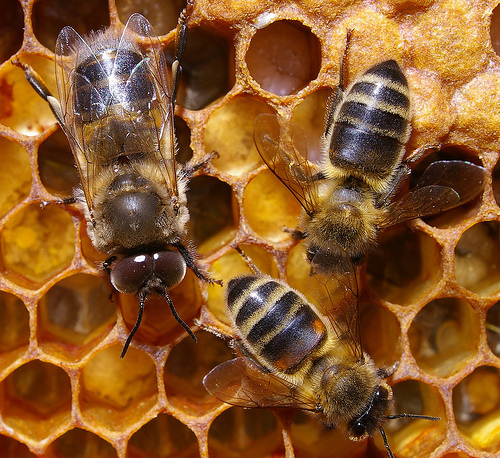Significant bee colony losses in New Zealand

Beekeepers fear an alarming phenomenon that is wiping out bees and leading to reduced food crops around the world has now reached New Zealand. Colony collapse disorder has caused American beekeepers to report losses of up to 90 per cent in some cases, prompting fears of crop shortages.
Honeybees are the planet’s most effective pollinators, and industry leaders in New Zealand are calling for an investigation into the problem. National Beekeepers Association said reports coming in to the group were causing concern. In the past six months they received reports of significant bee losses – up to 30 per cent in some places.
The reports had come from both islands, with big losses in Canterbury and Poverty Bay. The value of bees to the economy is estimated at about $4 billion a year because of New Zealand’s reliance on fruit, vegetable, dairy and meat, and fibre exports, all of which rely to some extent on pollination by bees.
Although the varroa bee mite has been blamed for losses in the past 11 years, the use of chemical treatments has been helping bee numbers recover. Now, concern has arisen about a new family of insecticides, neonicotinoids, which are used to coat seeds and control pests. They are neurotoxins and are believed to interfere with a bee’s nervous system.
Iinternational studies had shown neonicotinoids induced chronic mortality in bees. They had been identified as a potential cause of colony collapse disorder, which could decimate a bee population with devastating consequences.
Some uses of the chemical had been banned in Italy, Germany and France, and NBA said it was time for the Environmental Risk Management Authority to consider reassessing its use.
The association was surveying members to try to get an estimate of bee losses. (Stuff.co.nz)
The problem is a scientific one but scientists remain baffled about the cause of the pollinators decline. It’s not only honeybees that are affected but also other native pollinators that have thrived here for generations. Federal research dollars are now being made available with the new Farm Bill and will be put to good use in the study of this issue so vital on a worldwide basis…
The research focuses on native bees such as bumblebees that are also experiencing rapid declines and also on butterflies, moths, beetles, flies, hummingbirds and bats. It is known that these are all pollinators but a lack of scientific data on these species makes measurements difficult…
Scientists think there are a number of reasons for the decline, such as loss of habitat, pesticides, viruses and parasites. One study of 108 pollen samples revealed 46 pesticides with nearly 17 different pesticides in a single sample. Only three of the samples showed no pesticide residue.
Another factor in the decline and not nearly as well known as the other causes is large farm monocultures of single crops that result in “floral deserts.”
Researchers Find Virus May be Linked to Honey Bee Collapse (AAAS)
Millions of Bees Die – Are Electromagnetic Signals To Blame?
Fungus a possible culprit in bee loss
Loss of Bees Threatens Global Food System
Loss of bees will be a disaster (HoneyBeeCrisis)
Colony collapse disorder (CCD) is a phenomenon in which worker bees from a beehive or European honey bee colony abruptly disappear. While such disappearances have occurred throughout the history of apiculture, the term colony collapse disorder was first applied to a drastic rise in the number of disappearances of Western honey bee colonies in North America in late 2006. Colony collapse is significant because many agricultural crops worldwide are pollinated by bees.
European beekeepers observed similar phenomena in Belgium, France, the Netherlands, Greece, Italy, Portugal, and Spain, and initial reports have also come in from Switzerland and Germany, albeit to a lesser degree <3 > while the Northern Ireland Assembly received reports of a decline greater than 50%. Possible cases of CCD have also been reported in Taiwan since April 2007.
The cause or causes of the syndrome are not yet fully understood. In 2007 some authorities attributed the problem to biotic factors such as Varroa mites and insect diseases ( pathogens including Nosema apis and Israel acute paralysis virus). Other proposed causes include environmental change-related stresses, malnutrition, pesticides (e.g.. neonicotinoids such as clothianidin andimidacloprid), and migratory beekeeping. More speculative possibilities have included both cell phone radiation and genetically modified (GM) crops with pest control characteristics, though no evidence exists for either assertion.
It has also been suggested that it may be due to a combination of many factors and that no single factor is the cause. The most recent report (USDA – 2010) states that “based on an initial analysis of collected bee samples (CCD- and non-CCD affected), reports have noted the high number of viruses and other pathogens, pesticides, and parasites present in CCD colonies, and lower levels in non-CCD colonies. This work suggests that a combination of environmental stressors may set off a cascade of events and contribute to a colony where weakened worker bees are more susceptible to pests and pathogens.”
Applying proteomics-based pathogen screening tools in 2010, researchers announced they had identified a co-infection of invertebrate iridescent virus type 6 (IIV-6) and Nosema ceranae in all CCD colonies sampled. The study is the first to conclude that co-factors, the virus and fungus, were present in all of the collapsed colonies studied. However, scientists in the project emphasize additional research is still needed to consider how environmental factors like temperatures, drought and pesticides might play a role, if any, in CCD. (Wikipedia)



Commenting rules and guidelines
We value the thoughts and opinions of our readers and welcome healthy discussions on our website. In order to maintain a respectful and positive community, we ask that all commenters follow these rules:
We reserve the right to remove any comments that violate these rules. By commenting on our website, you agree to abide by these guidelines. Thank you for helping to create a positive and welcoming environment for all.